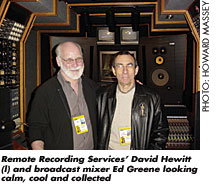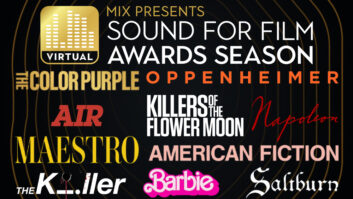
It’s another crisp winter night in L.A. Annie Lennox stands centerstage at the Kodak Theatre on Hollywood and Highland, clad in jeans andfaux fur and singing “Into the West” from The Lord ofthe Rings: The Return of the King, as if her very life depended onit. Backstage and in the orchestra pit, dozens of productioncrew-members bustle about, setting up and adjusting microphones,tending to the needs of the talent and musicians, talking softly buturgently into their RFPLs and cell phones.
Half a block away, Tommy Vicari sits hunched over a Neve VRM consolein David Hewitt’s Remote Recording truck, fingertips darting from faderto fader as he deftly mixes the 55-piece orchestra accompanying Lennox.Behind him, Hewitt quietly moves between three Neve 961 subcars,putting on and taking off headphones as he makes minute adjustments tothe string and woodwind submixes. From a squawkbox off to their leftcome the musings of an agitated director, alternately cursing outcameramen for missing their shots and cracking bad jokes about thedress sense of selected cast and crew.
In a TV satellite truck parked nearby, legendary broadcast mixer EdGreene is in the hot seat, though you’d never know it to look at him.Seemingly unflappable, yet deeply focused, he divides his attentionbetween two consoles: an analog Calrec and a digital Mackie D8B,blending the signal from nearly 100 onstage mics and numerous playbackmachines with Vicari’s orchestral mix. Issuing forth from the MeyerSound, KRK and JBL speakers surrounding Greene is a lush 5.1 spread ofthe entire melange.
And that’s just the rehearsal.
REPORTING FOR DUTY
It’s common wisdom that it’s big-budget shows like the annualAcademy Awards that drive the broadcast industry forward. This year’sextravaganza was a major case in point, transmitted simultaneously inboth high-definition and standard-def, with two separate audio streams:a discrete Dolby Digital — encoded 5.1 mix and a Dolby Pro LogicII — encoded signal, complete with split surrounds. True, it waslast year’s Grammy Awards show that first broke the ice in that regard,but the higher-profile Oscars not only boast a longer pedigree, butalso command a significantly larger worldwide audience.
Despite the leap forward, much of the production crew’s approachtaken this year was unchanged, thanks largely to the consistency ofpersonnel. (Hewitt has been doing the show for the past 12 years;Vicari and Greene for the past eight.) “The shift to 5.1 hasn’treally affected my job,” says Vicari, “because for me, it’sall about the music. I don’t worry about the technical details. I justworry about getting the signal from the players cleanly into theconsole and mixing it so the listener can hear the arrangement —hear all the elements the composer had in mind. Mind you, it does soundglorious in 5.1, having the image wrap around you; it’s inspiring tome.”
It’s a broadcast trend that all three men see as inevitable.“Surround sound is something that the public has embraced andnobody’s going to go back,” Hewitt says. “Actually, thewhole surround phenomenon is kind of amusing to me and to most remotemixers, because our goal has always been to re-create what you’rehearing in a concert. Trying to do that in stereo was always verydifficult, but we always miked in surround, so to speak, to try and getthe feel of the live venue. So, essentially, I’m not doing things awhole lot differently.”
Clearly, it’s Greene’s role that has been the most affected by thebrave new world of multichannel audio. “Things are getting verycomplicated,” he reports. “For this show, we actuallygenerated four separate mixes: a domestic 5.1 for HD, an international5.1 HD, a domestic SD-encoded and an international SD-encoded, with theinternational mixes excluding the show announcer and commercialbumpers. That’s pretty complicated stuff for a program that’s primarilya lectern show. I don’t want to minimize it, but there’s really justtwo lecterns and a center mic, plus the orchestra pit and a lot of filmcues. The thing is, the Oscars are a very high-profile show.”
Asked if he feels that production requirements are gettingtoo complex, he responds with a laugh: “No, not so far,anyway. But every show now presents a whole new set of requirements.Certainly, the 5.1 mix I put together for this year’s Academy Awardswas a lot more adventurous than the one I did last year.”
“It’s a ratchet,” Hewitt observes. “Every year itgoes up one click, and it never goes back.”
Greene’s enthusiasm for surround sound is obvious. “It’s agreat new palette, and I’m convinced it’s here to stay. DVDs aredriving it, of course; it’s delightful to watch movies that way athome. I’m even starting to watch movies off-air in 5.1 or even justSD-decoded. That’s quite nice, too, but the biggest issue now is syncbetween the audio and video signals. Sometimes it’s close and sometimesit’s not so close — often two or three frames off, sometimesmore. The problem is that the video gets processed so many differentways, and nobody really keeps track of where the audio is.
“In fact, I watched a live program not long ago that wastwo-and-a-half seconds out of sync for about 20 minutes. What happenedwas, the network took the audio from fiber and the picture fromsatellite, and then somebody called and complained, so they switched,but they switched both of them!” With a trace of resignation, headds, “We often have no control over what happens to the signalwhen it leaves our trucks.”
OPTING FOR DIGITAL GEAR
Another broadcast trend identified by all three mixers is anincreased reliance on digital equipment. “I have a MackieD8B,” Greene reports, “which I also used at the AcademyAwards show last year. It’s a very good-sounding desk. I used itprimarily for the two medleys in this show, and I haven’t had a failurewith it, but in broadcast, you always have to have a Plan B anyway. Thecontingency planning here included a stereo FOH mix coming up on themain desk, which I could immediately go to if necessary, and numerousbackup microphones already onstage.”
Hewitt notes that a requirement of HDTV is that broadcast audio mustultimately be converted to digital. At this year’s show, the conversionoccurred at the last possible stage via the Dolby Digital encodingprocess. But Hewitt foresees an inevitable shift toward having theconversion to digital occur at an earlier stage — eventually.“At the current time, digital equipment simply crashes with moreregularity than I’m willing to tolerate,” he says, “andthere are a whole bunch of issues that aren’t settled yet, things likesampling rate and bit rate, even format: PCM versus DSD, for instance.When the technology gets to the point where it is both standardized andstone-reliable, then I probably will make the move, not just to adigital console, but also to digital mic splitters because it’s so mucheasier to pipe around that way, and it reduces wire size and bulk. Itcomes down to the same old two-step: reliability and sound. Sure, I’dlove to have total resetability and remote control; that’s veryvaluable. At the same time, it can get you into trouble. When you’reforced into doing too much just because the equipment can do it, thenthe quality can suffer.”
Vicari takes a similar view, pointing out that this year, for thefirst time, all of the show’s pre-records were done in the digitaldomain. His main concern, however, is with ergonomics. “Digitalconsoles are wonderful devices, and I use them every day in recordingstudios, but in this kind of situation, I want to be able to look at afader and be certain that it’s showing me where the level is. I don’twant to be layers deep; I want to see everything in front of me.”Greene shares that concern. “Many of these manufacturers don’tconsult with broadcast mixers until after they have built theproduct,” he explains. “In fact, a lot of them don’tunderstand what we do. A product may have everything you want in it,but unless it’s got good ergonomics, it’s really not veryuseful.”
Greene also predicts an increasing reliance on console-basedplug-ins, if for no other reason than time constraints. “Comewhat may, we know that at 5:30 on a Sunday night, we’re going on-air;whether it’s a full-fledged digital 5.1 mix or a string and a cup,we’re going on the air. So you do the best you can with the time andtools available.”
GEARING UP FOR SHOW TIME
Rehearsal time, in fact, is typically so tight for these kinds ofshows that all three engineers have developed the practice of recordingrehearsals and then spending significant time afterward playing thetapes back to refine their mixes. “It’s invaluable being able todo that, because it’s expensive having an orchestra here,” Vicarisays. “During the few hours that we have them, we’ll get a basicbalance and echo level and then take a snapshot; that gives us astarting point. Of course, this is a grueling event: The players haveto sit in the pit for eight hours at a time, so they don’t really givetheir all until the show, which means that the level settings that Igot in the rehearsals don’t necessarily mean anything. I try to givemyself some headroom, because I know that when the show starts,everybody gets excited and plays harder.”
Like the musicians, everyone responsible for the audio at theAcademy Awards plays a sharply defined role. In addition to doing theorchestral mix during the show itself, Vicari was charged withoverseeing the pre-records at Capitol Studios in the days leading up tothe broadcast. During that time, Hewitt and Vicari’s brother, Dan, didthe pit setup and cross-patching. Interestingly, the mix generated bythe Remote Recording truck was not a full 5.1 channel. Stereoorchestral stems were provided to front-of-house mixer Pat Baltzell,and only left, right and LFE channels were sent to Greene, who thencreated the center and rear channels and handled all of the onstagemics.
“I certainly was not adding audience or dialog to the LFEchannel Tommy sent me,” Greene explains. “I simply added alittle bit of bass and other low-frequency instruments, as well as alittle bit of the clip playback — whatever seemedappropriate.” Greene opted to use the center channel strictly fordialog and vocals, which were also placed in the front left/rightspeakers to create both phantom and hard center imaging.
The content placed in the rear channels was a subject ofconsiderable discussion during pre-production planning. “I neverfelt that music should be coming from the back,” says Vicari.“I was never a fan of that in these kinds of situations, becausethe audience perspective is that the orchestra is coming from thefront, and the listener should feel like a participant in theshow.” It’s a philosophy that Greene agrees with: “Youwouldn’t want to have instruments happening in back of you for thisparticular project, which is really a proscenium show, so I basicallyjust took Tommy and Dave’s two-mix and spread it around the sides alittle bit.”
Greene’s tools of choice for that purpose included more than a dozenstrategically placed ambience microphones in the theater and a pair ofvenerable Lexicon 200 reverbs. “I view broadcast audio as beingbroken down into different areas,” he explains. “Dialog orvocals are the story of the program; the music and effects are thefeeling of the program; and the audience reaction is what connects theartist to the audience. That’s the element that puts the listener atthe venue.”
However much time and effort is spent creating the 5.1 mix, Greeneis a realist, noting that few viewers actually get to hear the showthat way. “Especially with a program like this that runs so late,a lot of people are watching on TV sets in their bedrooms, so they’reoften listening in mono.” As a result, once the basic 5.1 mix isset, he generally monitors in mono at modest levels of 70 to 75 dB SPL,relying mostly on metering (through a Dolby LM100) to keep track of thesurround mix. This time around, though, Greene experienced thingssomewhat differently. “I found that when I was listening in monoor stereo, I wasn’t able to hear some of the subtleties that were goingout in surround, so for about the last two hours of the show, Ilistened mostly in 5.1.”
Over in the Remote Recording truck, Vicari and Hewitt had the luxuryof switching between monitoring the 3-channel signal that they sentGreene and the pre-encoded 5.1 mix that he was constructing; with theuse of their Martinsound controller, they even had the capability todownmix the 5.1 to mono or stereo. In essence, a symbiotic loop wascreated: As Vicari monitored Greene’s surround mix, he was able to makeadjustments to the orchestral contribution in real time that, in turn,affected Greene’s final decision-making.
Greene is a veteran of both the Academy Awards and the Grammys, andhe points out that a key difference between the shows is that the musicmix at the Oscars is easier to control because the orchestra pit isstationary; at the Grammys, he has to contend with stageinstrumentation that’s constantly changing. The Grammy audio productionteam also takes a different approach to creating the 5.1 mix, routingstems and musical elements to a separate truck dedicated to thatpurpose.
This time around, there were no significant audio hiccups at theAcademy Awards; certainly nothing on the scale of the Celine Diondead-microphone gaffe at the Grammys. “But that’s what happens inlive shows,” Greene points out, “and unfortunately, theonly thing that really sticks in people’s minds. You can pull off theaudio feat of the century, and as long as there’s nothing that disturbspeople at home, they just say, ‘Oh, that’s nice.’ However,if one microphone goes out, ‘Oh my God!’ In the broadcastworld, audio may still be the stepchild of video — see a dog,hear a dog — and it is true that the better it looks, the betterit sounds. But,” he adds with a grin, “it’s equally truethat the better it sounds, the better it looks.”
Howard Massey’s latest book, Behind the Glass, is acollection of interviews with top record producers andengineers.




